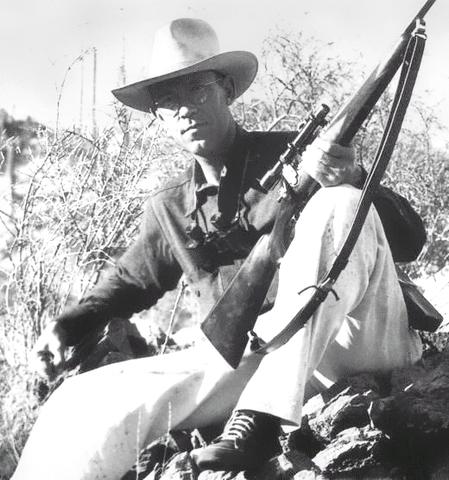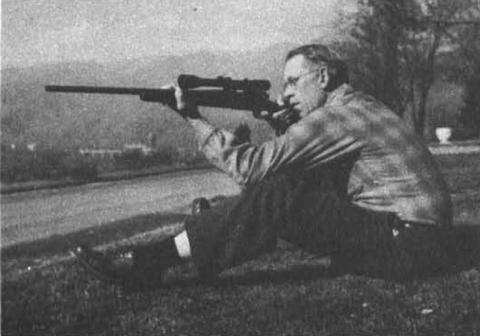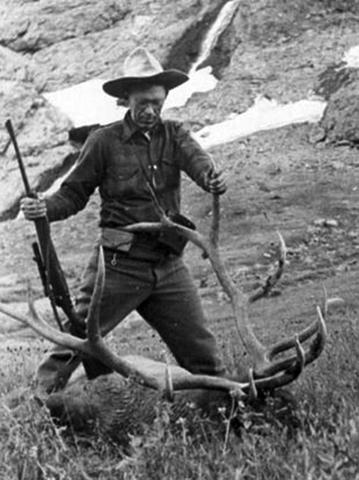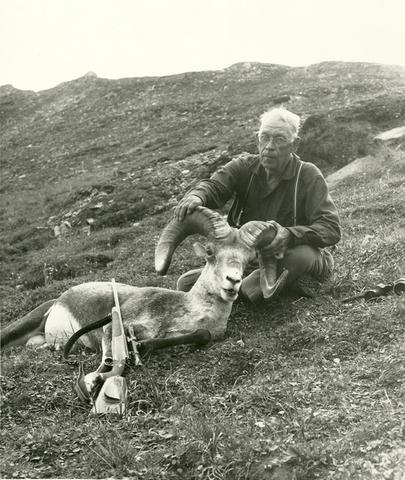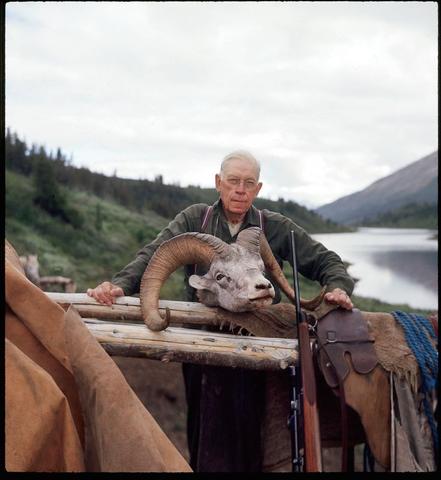Recent article from the campfire at pre64win.com
~ Intertwined ~ The Inseparable Legacies of Jack O'Connor and the Winchester Model 70
Oct 24, 2019
View attachment 311639
Jack O'Connor poses with an Eland and his .375 H&H model 70
The year was 1936. Winchester had just introduced a new sporting rifle - the model 70 - and a young journalism professor at the University of Arizona was making a name for himself as a prolific freelance writer on outdoor topics and especially on the subject of hunting. The professor’s articles were a unique blend of adventure and technical detail, telling gripping stories of the hunt yet without ignoring the science of the rifle, the cartridge, and the shot. His writings were punctuated with humor, clever plays on words, and an acerbic wit that only added to their appeal. As the popularity of the author and his articles grew, the professor's writings appeared in everything from Sports Afield and Field & Stream magazine, to Redbook and the Saturday Evening Post. By the end of 1936 the professor had signed an exclusive contract to write for Outdoor Life magazine and ‘Jack O’Connor’ became a household name.
Over the 50 years that followed, no individual contributed more to the legacy of the Winchester model 70 than Jack O'Connor. O’Connor’s was enormously influential in making the pre-64 model 70 desired, and also in making the post-1963 model 70 despised. As such, it is impossible to separate the legacy of the model 70 from that of Jack O’Connor.
JACK O'CONNOR IS THE CENTRAL FIGURE IN THE HISTORY OF THE WORLD'S MOST SUCCESSFUL SPORTING RIFLE
Born in 1902 and a life-long hunter, O’Connor’s interest in rifles began long before the model 70, or even its predecessor - the model 54 - was ever imagined by the designers in New Haven. In O’Connor’s early years he hunted the deserts and mountains of the southwest US, carrying the surplussed military rifles which were so common for his day - often a Mauser or Springfield rifle. Unmodified, these rifles were awkward and heavy, but well-designed, reliable and accurate. When finances enabled it, O'Connor commissioned a sporterized version of the 1903 Springfield for his hunting rifle. It had a compact stock made by Adolf Minar of Colorado fitted to a modified 03 action with a 22-inch barrel made by by William Sukalle of Tucson. The rifle was chambered in 7x57mm Mauser. It was O'Connor's first truly custom rifle.
A young O'Connor with his Sukalle-Minar Springfield
In 1925 Winchester introduced the model 54. For all the shortcomings of the Mauser and Springfield rifles, O’Connor was drawn to the model 54 at least in part by his experience with and his appreciation for the military rifles which inspired it. Ignoring the weight and other limitations of the military rifles, O’Connor appreciated the quality of their build and the precision and reliability of their controlled round feed action design. It was these things which attracted O'Connor to the model 54. Winchester had brought the quality and technology of the Mauser action to the sporting rifle. It is no surprise that in the year it was introduced, O’Connor purchased a standard grade model 54 rifle chambered in .270 W.C.F. This purchase set O'Connor and Winchester on an intertwined course that would last the next 52 years of O'Connor's life, and for decades beyond his death.
In 1936 Winchester perfected the model 54 design with the introduction of the model 70. A ground-breaking safety design was incorporated, barrel steel was improved, and a trap-door floorplate was added to an already great model 54 design. O’Connor saw it for what it was - a further improvement to an already great sporting rifle. Writing about the new model 70 rifles, O'Connor said:
“My experience with the Model 70 actually goes back to the fall of 1925 when I bought my first Winchester Model 54 in .270 caliber. The Model 54 was really sort of a primitive Model 70, or the Model 70 is a refined Model 54.”
In the model 54 and then subsequently in the model 70, O’Connor found the sporting rifle refinements he desired, but without sacrificing the quality of the controlled round feed action design. From his earliest days at Outdoor Life O’Connor wrote often and favorably about the Winchester model 70.
But nobody and certainly no rifle received a free pass from O’Connor, not even the model 70. If he had one complaint about the model 70, it was the rifle's weight. O’Connor realized the sturdiness of any rifle came at a price, but on the topic of the model 70’s heft, he employed his classic sarcasm:
“She’s all rifle, a yard wide, and built like the brick edifice in Mrs. Kelly’s backyard. For mountain hunting she’s a bit on the heavy side, though, and with certain scopes and mounts she’s likely to weigh 10 or 10½ pounds.”
In 1939, O’Connor was promoted to the position of full-time gun columnist for Outdoor Life - a position for which he resigned from his professorship in Arizona. He was promoted again to the position of Arms and Ammunition Editor at Outdoor Life in 1941. O’Connor’s role at Outdoor Life magazine positioned him for enormous influence with hunters and shooters worldwide – influence he would hold and wield for his entire life.
O'Connor shoulders a model 70 varmint rifle
By the late 1940s, O’Connor had developed a deep affection for sheep hunting. The beauty and remoteness of sheep country, the ruggedness of the terrain, the intelligence of the prey, and the particular challenge of the shots sheep hunting required all combined to make hunting sheep into O’Connor’s life-long passion. O’Connor’s skill and enthusiasm for sheep would result in at least 3 grand slams before the term even had official meaning in the world of sheep hunters and his pursuit of sheep would eventually take him to 5 continents in search of his favorite game. This focus on sheep also set O’Connor on a quest to find the perfect sheep rifle.
With his influence in the world of hunting, O’Connor had access to pretty much whatever rifle he chose and whatever customizations he desired. It is safe to assume that for his personal sheep rifle, O’Connor hunted with the rifle he felt was best suited for the task. Beyond his affinity for the controlled round feed action, in his 1952 book The Big Game Rifle, O’Connor wrote about the ideal stock, saying:
“A good sporting stock should enable the shooter to get a shot off quickly and accurately, and it should also be a thing of beauty”
O'Connor added...
“Many fine sporting stocks are handsome but of little aid in accurate shooting. Many others that hold and shoot well are homely and clumsy. The very best sporter stock design results in a stock with handsome, graceful lines and one which also enables the man behind it to do his best work.”
From before he purchased his first model 54, O’Connor had been a fan of the .270 Winchester - it was his preferred hunting cartridge. Certainly, O’Connor owned rifles in many different chamberings. In the model 70 alone, O'Connor owned a .220 Swift, .257 Roberts, .270, .30-06, .375 H&H and at least 4 others. When the circumstances or the quarry demanded something other than the .270, O'Connor would oblige. Regardless, the .270 never lost favor with him. In the face of numerous new cartridges being introduced over his 5 decades of shooting and hunting - many of which O’Connor tested and wrote about - he found no compelling reason to switch to something other than the .270 Winchester as his favorite cartridge. For sheep and most other hoofed animals, O’Connor stuck with the .270 expressing his confidence in it when he wrote:
“If the hunter does his part, the .270 will not let him down”.
With the .270 being the second most popular chambering for the model 70, O'Connor had more than one reason to like the rifle. But the heft of the model 70 remained a concern. Not just for O'Connor, but for the sporting rifle in general. In 1952, rumor of a forthcoming lightweight model 70 was circulating and in anticipation this "Featherweight" model 70, O'Connor would write:
“Now, chaps with varicose veins and fallen arches find lugging standard Model 70s over hill and dale a bit burdensome. So these rumors of a light musket interested me vastly, not only because my own legs have been worn off halfway to the knees by lugging heavy rifles over sheep mountains, but because many of the letters I’ve had plead for a rifle light enough to be transported by elderly characters without the aid of a dog team.”
As much for himself as anyone else, O'Connor was hopeful the rumors were true and wrote hilariously about Winchester's ability to keep the new rifle under wraps.
"Never let it be said that Winchester can’t keep a secret. Once at the factory a hired hand drew me aside and was about to spill the dope. He glanced furtively about, his eyes rolling in fear. Then he drew my ear close to his lips and began to whisper, “Now this is absolutely confidential, but I’ll tell you what we plan to do.”
Just then a secret porthole in the wall slid open. There was a flash and a hiss through the air, and a silver-mounted Malay dagger buried itself in the wall within an inch of my pal’s head. He fainted dead away, and when he finally revived I did not press him further.
For as much as O'Connor had the inside scoop on the soon to be introduced Featherweight rifle, his hunches about the chambering of this new rifle were not only incorrect, but were personally disappointing. The Featherweight rifle was not offered in O'Connor's preferred .270.
With my well-known feminine intuition, I had it doped out that the Winchester featherweight, if and when it materialized, would be in the .270 and .30/06, the best selling calibers in the good Model 70. That seemed only logical, but alas, the world does not always operate on a logical basis.
The featherweight has now arrived—and with it a mysterious new cartridge, the .308 W.C.F. It’s this cartridge, for which the rifle’s chambered, that’s the real surprise."
Unfortunately for O’Connor (and perhaps for Winchester as well), the new model 70 Featherweight rifle would be introduced in a new cartridge - the .308 Winchester - and was not initially offered in O'Connor's preferred .270. Wary of the new cartridge and not about to let it replace his beloved .270, O'Connor steered clear of the new lightweight model 70.
O'Connor with a 6x6 Rocky Mountain elk and a model 70 standard rifle
In 1954 Jack O’Connor would settle on the perfect combination of rifle and stock, choosing an exceptionally accurate Winchester model 70 standard rifle chambered in .270 Win as his sheep rifle. The Winchester barrel and action was unmodified, except for removal of the sight ramp and the addition of a Lyman All-American scope in Tilden mounts. The action was fitted to a straight-grain French walnut stock which eliminated the barrel screw. The stock had a straight comb, raised cheekpiece, finely checkered panels with sweeping curved edges, and an ebony forestock tip. At just over 8.5 lbs, the rifle was light enough to be carried into difficult terrain, while the 24” Winchester barrel and .270 cartridge with 150 grain partition bullets delivered consistent 1 MOA performance. O’Connor was thrilled and referred to the rifle as “sheep rifle No 1”. O’Connor both hunted with and wrote about his number 1 rifle in the years that followed.
By 1959, and partly out of concern for how much use No. 1 was seeing, O’Connor was looking for a second sheep rifle. O’Connor had left his native Arizona a decade prior and was living in Lewiston Idaho. It was in Erb Hardware of Lewiston that O'Connor picked up a Featherweight model 70 in .270 and decided to see how the rifle would shoot. He was surprised and elated to find the 22” Featherweight could outperform his heavier number 1 rifle. He purchased the rifle and delivered it to Al Biesen in nearby Spokane Washington for customization. Biesen removed the sight ramp, checkered the bolt knob, jeweled the bolt shaft, extractor and follower, revised the tang to look more like the pre-war model 70, added a custom trigger bow, and tuned the trigger. Other than these fairly modest and mostly cosmetic modifications to the barrel and action, Biesen left the Winchester parts alone. For a stock, Biesen fitted the action to a fine piece of French walnut. The stock had a straight comb with a raised cheekpiece and featured finely checkered panels with fleur-de-lis accents with an ebony forestock tip. Biesen added a grip cap engraved with the head of a moose and a trapdoor buttplate ornately engraved with a bighorn sheep. The rifle was topped with a Leupold Mountaineer 4X scope in very compact Tilden mounts. The completed rifle was handed back to O’Connor in 1960 weighing right at 8 lbs. After testing and load development, O'Connor found the rifle liked 130 grain Nosler partitions and would punch the paper at slightly less than 1 MOA. O’Connor was delighted. He christened the rifle “sheep rifle No. 2” and it would become the one rifle O’Connor never moved on from. The most famous and best documented of all his rifles, O’Connor would hunt with and write about sheep rifle number 2 until his death in 1978.
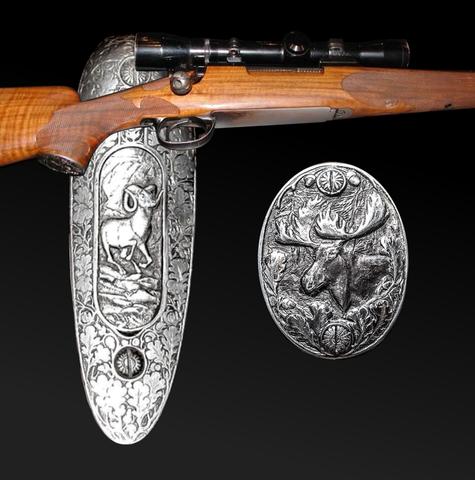
O'Connor's Sheep Rifle No. 2 - a 1959 Featherweight in .270 Win
O'Connor with a Stone sheep and Sheep Rifle No. 2
For all of its greatness, the model 70’s undoing came at the hands of inferior rifles. In the late 1950s, Winchester was facing competitors offering rifles which cost much less to produce and this pressure on Winchester margins was weighing heavy on the company's bottom line. By 1960 and in response to a failing business, Winchester had begun making changes to reduce its cost to produce the model 70. The quality of wood used in model 70 stocks went down and hand checkering of the stocks gave way to machines which produced small, lifeless checkered panels. These things were anathema to O’Connor, who always believed the stock was of central importance to a rifle. But the final straw came in 1964 when Winchester abandoned the controlled round feed action design in favor of the simpler push feed designs used on all other sporting rifles. O’Connor was utterly unimpressed. For all the praise he had heaped upon the pre-64 model 70, his measured comments dripped with disdain for the new 1964 design. Of the new model 70 he would write:
“Winchester has probably run the wants of rifle purchasers through a Univac and has come up with exactly the answer as to what the lads with $274.95 to spend dream about. The new stock is not exactly my cup of tea, but that is neither here nor there. I am a mean, opinionated old mossback, and if they made stocks to please me they’d go broke.”
It is not disputed that O’Connor played a central role in making the pre-64 model 70 the most desired and respected bolt action sporting rifle in history. It is equally true that with his vast following, O'Connor's thinly veiled contempt for the revised 1964 design was equally powerful in creating an overwhelming preference for the pre-64 rifle. In a phenomenon rarely seen, the new rifle design created instant demand for it's predecessor. 56 years later, O'Connor's influence and the phenomenon of preference for the pre-64 rifle continues.
O'Connor with Sheep Rifle No. 2 and a nice full-turn ram
O'Connor passed away in 1978 and never had the opportunity to see how the model 70 would evolve beyond the push feed design of the late 1960s and 1970s. But if he had, this writer believes he would be pleased. In the 1980s finishes and many of the materials used in the model 70 were dramatically improved. In 1992 Winchester began reintroducing many of the pre-64 design features, including the controlled round feed action design O'Connor preferred. In 2006, all model 70s returned to the pre-64 style action, which continues to this day. The modern model 70 has returned in many ways to its former glory, with superb levels of quality, the legendary pre-64 design, and the critical acclaim it rightly deserves. No doubt, in very measurable ways, Winchester's decision to return the model 70 to some semblance of its former glory was a result of O'Connor's enormous clout. Even decades after his death, O'Connor's influence unquestionably still shapes how the world views what a model 70 should be.
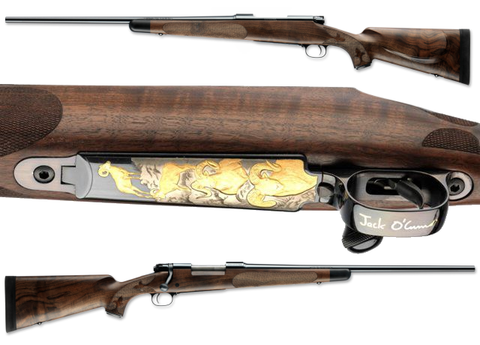
Winchester's Jack O'Connor tribute rifle
At Shot Show 2012 and in celebration of the 75th Anniversary of the model 70, Winchester unveiled a limited edition Jack O'Connor tribute model 70. It was a modern controlled round feed action mated to a featherweight barrel and chambered the only cartridge that made sense - .270 Winchester. The stock was made from fancy grade French walnut with a black forestock tip and finely checkered panels featuring fleur-de-lis accents. It was a modern day version of O'Connor's Sheep Rifle No 2. This tribute was a bold move that would have seemed preposterous if Winchester had done it with the rifle they were producing at the time of O'Connor's death. But as it is, we believe the tribute rifle is worthy of its namesake and a rifle Jack would be pleased bears his name.
The tribute rifle is a fitting symbol of O'Connor's place in model 70 history. From the larger-than-life writer who made the pre-64 model 70 into the must-have sporting rifle for all serious hunters, to the influence of a legend in reshaping the model 70 even decades after his death; In ongoing and very tangible ways, O'Connor's legacy remains inseparably intertwined with the Winchester model 70.

